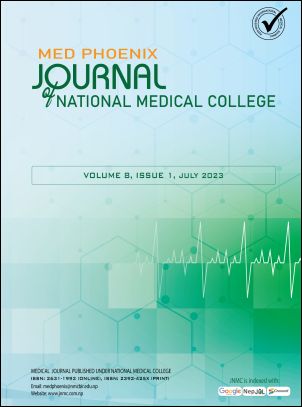Histopathological Findings in Postmenopausal Bleeding
DOI:
https://doi.org/10.3126/medphoenix.v8i1.56924Keywords:
Cervical Carcinoma, Endometrial Carcinoma, Endometrial Hyperplasia, Endometrial Sampling, Postmenopausal BleedingAbstract
Introduction: Postmenopausal bleeding is commonly considered a significant and alarming indicator of genital diseases. The term "postmenopausal bleeding" typically refers to uterine bleeding. Since it is a sign of many different etiologies and has a strong correlation with malignancy and conditions with substantial morbidity and mortality, prompt identification and treatment are desired for postmenopausal bleeding.
Materials and Methods: It is a retrospective cross-sectional observational study carried out in the pathology division of KIST Medical College and Hospital, Lalitpur, Nepal. From July 2017 to July 2022, 270 endometrial and endocervical biopsy samples with a history of postmenopausal bleeding were included. Following microscopic analysis, frequencies of histological findings in various age groups were generated. To determine whether the difference was significant, chi-square and proportions were used; the cutoff value was set at p 0.05.
Results: On average, the patients were 51.9 years old, plus or minus 6.6 years. Of the 270 samples included, 222 (82.2%) were endometrial biopsies, and the remaining samples were cervical biopsies. Endometrial hyperplasia was the most common histological finding overall, occurring in 67 (24.8%) of the patients. With a mean age of 65.33 years, endometrial and cervical cancer patients were between the ages of 51 and 79. Endometrial and cervical carcinomas were together present in 31 (11.48%) of the patients. Leiomyoma was one discovery; others included endometritis, adenomyosis, endometrial polyps, hormonal deviations, and disordered proliferative endometrium. Endometrial hyperplasia was discovered in 20 patients over the age of 50 and 47 patients under the age of 50; this finding is statistically significant at a p-value of 0.05.
Conclusion: In postmenopausal bleeding, benign diseases predominated, but the proportion of endometrial and cervical cancers and pre-malignant disorders was rather high. Our study demonstrates the significance of the endometrial sample, particularly in peri/postmenopausal women who have atypical uterine bleeding.
Downloads
Downloads
Published
How to Cite
Issue
Section
License
Copyright (c) 2023 Med Phoenix

This work is licensed under a Creative Commons Attribution 4.0 International License.
Copyright on any research article is transferred in full to MED PHOENIX upon publication. The copyright transfer includes the right to reproduce and distribute the article in any form of reproduction (printing, electronic media or any other form).
© MEDPHOENIX
![]()
Articles in the MED PHOENIX are Open Access articles published under the Creative Commons CC BY License (https://creativecommons.org/licenses/by/4.0/). This license permits use, distribution and reproduction in any medium, provided the original work is properly cited.




